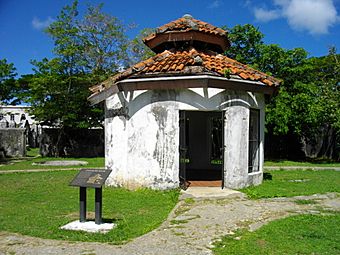Plaza de España (Hagåtña) facts for kids
Quick facts for kids |
|
|
Plaza de España
|
|

The "Chocolate House"
|
|
| Location | Saylor St, Hagåtña, Guam |
|---|---|
| Area | 0.4 acres (0.16 ha) |
| Built | 1736 |
| Architectural style | Spanish style |
| NRHP reference No. | 74002302 |
| Added to NRHP | May 1, 1974 |
The Plaza de España (which means Spain Square) is a historic place in Hagåtña. This city is the capital of Guam, a territory of the United States. For a long time, when Spain ruled Guam, this plaza was where the Governor's Palace stood.
Most of the palace was destroyed during World War II. This happened when Hagåtña was bombed during the battle to take Guam back. However, some parts of the old palace still stand today. These include a three-arch gate, an outdoor porch called the Azotea, and the famous Chocolate House. The Plaza de España was added to the National Register of Historic Places in 1974. This means it's recognized as an important historical site.
Contents
A Look at the Plaza de España
The Plaza de España is right in the middle of Hagåtña. It served as the home and office for the Spanish Governor from 1734 until World War II began. Even though much of it was destroyed, some parts have been saved or rebuilt. These include the Azotea, the Chocolate House, a Tool Shed, a Siesta Shed, and some old Spanish walls.
The Governor's Palace was called Casa Gobierno under Spanish rule. It was rebuilt in 1885 because the first one, built in 1736, needed to be replaced. The new palace was a two-story stone building. It had a balcony that stuck out and a roof made of clay tiles. The living areas were upstairs. Downstairs, there were offices for soldiers, places to store weapons, and other offices.
Changes Under American Rule
When America took control of Guam, the palace changed. A cement floor was added. The storage rooms downstairs became offices for managing things. The second floor had a reception area, a dining room, galleries, and the private home of the governor and his family. The kitchen and servants' rooms were at the back of the palace.
The Azotea, which is a raised outdoor terrace made of stone, survived World War II. It was originally an open-air porch for the palace. A clay tile roof was added to it after the war.
The Plaza's Importance Through History
Under Spanish rule, the Plaza de España was a very important place. Many government and community events happened here. The main building in this area, the Casa Gobierno (Governor's Palace), was first built in 1736. The first Spanish Governor to live there was Francisco Cardenas Pacheco.
The complex was first named Plaza de Magalahes, which means Governor's Plaza. Later, its name was changed to Plaza de España. Its look also changed over the years. In 1885, Governor Don Enrique Solano replaced the original palace with a bigger building.
After the Spanish–American War in 1898, Guam became a possession of America. The Plaza continued to be the main office for American leaders. It was also the official home of the Navy Governor.
Under American control, the plaza was made bigger. It even included a baseball field and a badminton court. Today, a bandstand called the Kiosko stands where the baseball field used to be.
World War II and Beyond
World War II brought even more changes to the Plaza. On December 10, 1941, after a short battle, the Governor, Captain George J. McMillin, surrendered Guam to the Japanese from the Plaza. Later, when the Japanese leaders were based there, the Plaza was badly damaged. This happened during the July 1944 bombing of Agana, just before Guam was freed.
The buildings that were still standing were later fixed up. However, a big repair project wasn't fully finished until 1980.
Today, the Plaza de España is still used for many social and community events. This includes when the Governor of Guam officially starts their job. This shows how important the Plaza remains in Guam's history.
See also
 In Spanish: Plaza de España (Agaña) para niños
In Spanish: Plaza de España (Agaña) para niños


